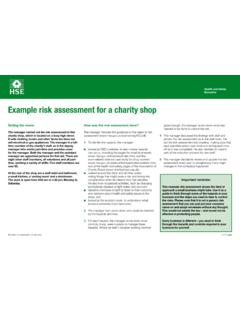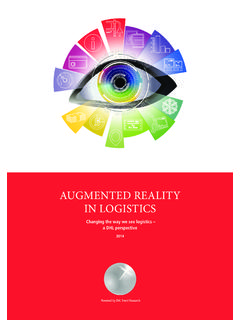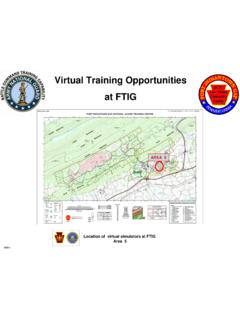Transcription of Health and Safety Issues associated with Virtual Reality ...
1 Page 1 of 23 Health and Safety Issues associated withVirtual Reality - A Review of Current Costello, July 23rd, 1997 Patrick CostelloAdvanced VR Research CentreDept. of Human SciencesLoughborough UniversityLoughboroughLeicestershireLE11 1 NLAbstractVR techniques provide the user with a new and more powerful method of interacting with computers than thetraditional techniques of keyboard and mouse. As such, there are many potential VR applications in areas such asentertainment, medicine and engineering and many research groups in the UK and abroad are now investigatingthis technology with the view to developing commercially viable products.
2 There are various implementations ofVR and these can be placed broadly into three categories; desktop, semi-immersive and fully immersivedepending on the sophistication of the technologies being However, the exploitation of this technology hasnot been without it s drawbacks. A number of recent reports have suggested that the use of VR equipment mayhave unwanted physical, physiological and psychological side-effects. This report provides an overview of currentresearch in this area, the principal findings and the relationship between potential side-effects and the VRimplementation being used.
3 It is hoped that this report will provide a thorough overview of the area of VR healthand Safety for members of the AGOCG user commumity who are considering buying, or already own, a of Contents1. Introduction Brief History Examples of Applications Scope and Purpose of report 2. Types of VR system Non-Immersive (Desktop) Systems Semi-Immersive Projection Systems Shutter Glasses Fully Immersive Head-Mounted Display Systems Head Mounted Displays (HMDs) Comparison between VR Implementations 3. Health Issues associated with VR Use Page 2 of Physical Posture Repetitive Strain Injuries (RSI) Headset Weight and Fit Hygiene Issues Immersion Injuries Physiological visual Issues Simulator Sickness Symptoms Simulator Sickness Symptom Theories Psychological Potential Health Benefits 4.
4 Discussion 5. Acknowledgement 6. References Page 3 of 23 IntroductionTraditionally, interaction with a computer has involved the use of a keyboard, mouse or joystick/trackball deviceto input information and the use of a visual display unit (VDU) to receive output from the system. With thedevelopment of Virtual Reality (VR) systems, new interaction methods have been developed that allow the user to step into computer generated ,or Virtual , environments (VEs) which is achieved by immersing the user in thesynthetic environment. This can be achieved by various means including the wearing of enclosed Head-MountedDisplays (HMDs) which may provide stereoscopic images of the VE and by tracking the motion of the head,hands, fingers, and other limbs of the body using magnetic or optical tracking systems.
5 Ideally, it is desirable thattracked movements of the body are updated in real time, but limitations to the currently available technologiesdictate that this is not always the of the greatest strengths of this new technology is that developers of VEs are not constrained by traditionallimits. Kalawsky (1996) identifies a number of key advantages provided by VR techniques:Simulation of complex systems. Macroscopic and microscopic visualisation. Fast and slow time simulation. Allow high levels of interactivity. Allow a sense of immersion. Inherent flexibility/adaptability. The potential applications of VR technology are vast and a great deal of research is currently underway in manycommercial and academic institutions to develop these technologies into effective useable systems.
6 However, anumber of recent reports have raised concern that there may be a downside to the exploitation of this newtechnology, suggesting that users may experience physical, physiological and psychological side-effects afterusing this type of equipment. Many of the early reports received extensive media coverage, which in many caseswas misleading, sensationalist and inaccurate. The purpose of this report is to highlight the potential side-effectsthat have been discussed in literature to date and to attempt to place them in the correct perspective. In this way,users and potential users of VR systems will have some indication of the side-effects that they may experience andthe generally accepted reasons for their HistoryAlthough VR is touted as a revolutionary new technology, the idea of inclusion within an artificial environment isnot new.
7 In fact VR can be considered an extension of ideas which have been around for some considerable timesuch as flight simulation, Sensorama (Heilig, 1962) and wide screen cinema (such as Cinerama and IMAX).Using such systems, the viewer is presented with a screen which takes up a large portion of the visual field givinga powerful sense of presence or being there .Two major breakthroughs occurred in the 1960 s with the arrival of the minicomputer and the work of IvanSutherland in 1965 entitled "The Ultimate Display ". In this paper Sutherland prophesied the development of thefirst HMD, which he was later to achieve with an HMD called "The Sword of Damocles".
8 Sutherland also realisedthe potential of computers to generate images for flight simulation, where, previously images were generatedusing video ideas were combined by two NASA Ames scientists, Fisher and McGreevy, working on a project called the Virtual workstation in 1984. From these ideas NASA Ames developed the first commercially viable HMD,called the visual environment display (VIVED), which was based on a scuba divers face mask with the opticalscreen displays supplied from two Sony Watchman hand-held televisions. This development was unprecedented,as NASA had an HMD that could be produced at an affordable price and the VR industry was of ApplicationsPage 4 of 23VR research and development projects are currently underway world-wide in large organisations such as NASA,IBM, Intel, Boeing and Rolls Royce.
9 To give some indication of the incredible flexibility of VR techniques, anumber of current and diverse VR applications are listed , in conjunction with Bravo Multimedia, have developed a simulator to evaluate the skills of their tankerdrivers. The simulator is known as truck driVR, and uses an Intergraph PC and a Virtual Research FS5 using the simulator, the driver is placed in charge of a Kenworth truck hauling 40,000 gallons of fuel. Thesimulation is made up of 21 events such as a deer crossing the road, a car backing out of a drive and an ambulanceon an emergency call driving past and these events can occur on an urban or rural route.
10 The driver is assessed ontheir ability to cope with the various events and all sessions are video-taped and reviewed with an instructor. The systems are built into vans and taken around the country. The purpose is to develop a better system of driverevaluation than the one individual evaluation a year that Amoco currently employ. Truck driVR remains underdevelopment and is currently being offered to other fleet operators as a driver evaluation Wilson Group, based at the University of California, San Diego are developing the Virtual Explorer learningtool. They are currently developing a Fantastic Voyage Virtual environment that allows the user to shrink downto cellular scale and travel through the human vascular system, observing the interplay of the fundamentalcomponents of the immune system and the bodies response to foreign invaders.






